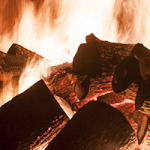Wood Burning Stoves, are they environmental friendly?
We all want to keep warm over the winter months, and a classic wood-burning stove is an attractive option for doing so, but is it environmentally friendly? Well, in short, yes and here are some reasons why:
It’s renewable
Trees can be cut down for their wood and provide fuel for many different fires. But the most important part is that new ones can be planted to replace the old, something that can’t be done with coal or gas which is very much a finite resource.
Dry wood is also the best burner, wood often found in dead or dying trees, so don’t feel guilty about trees being cut down! Even logs and sticks shed from decaying trees would be more than good enough to fuel a good fire.
Worried we may run out? Well, don’t worry. The UK alone has 30,000 football fields, or 16% of its surface area, covered in trees that are constantly being born, growing and dying. Even if that were to fail by some catastrophic miracle, there are a great many more worldwide. Wood will continue to be a cheap and renewable source of energy well in the future.
It has no carbon footprint
Now, even the cleanest stove will still cause some pollution, but any form of wood burning will produce no Carbon footprint. How? The reason for that is that trees take in CO2 from the Atmosphere and turn it into oxygen throughout their natural life cycle.
This means, any CO2 produced by burning wood can be neutralised by the trees and that are still alive. Resulting in no carbon footprint, something that can’t be said for the fossil fuel alternatives.
Modern stoves are cleaner than ever!
As I mentioned, even the cleanest will cause pollution, but modern wood burning stoves easily rank the lowest for pollutants produced. Oil and Coal producing up to four times more. Add onto that benefit the previous two factors and there really is no cleaner source of heating.




Leave a Reply
Want to join the discussion?Feel free to contribute!